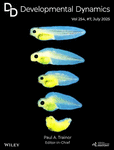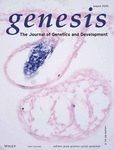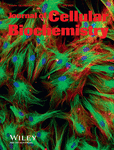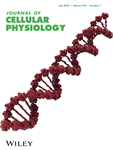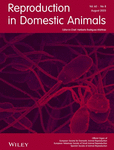AUTHOR GUIDELINES
SECTIONS
- Submission
- Aims and Scope
- Manuscript Categories and Requirements
- Preparing the Submission
- Editorial Policies and Ethical Considerations
- Author Licensing
- Publication Process After Acceptance
- Post-Publication
- Editorial Office Contact Details
1. SUBMISSION
All new and revised submissions should be made via the Research exchange portal (https://wiley.atyponrex.com/journal/MRD). For technical help with the submission system, please review our FAQs or contact [email protected] .
Note, this journal uses iThenticate’s CrossCheck software to detect instances of overlapping and similar text in submitted manuscripts.
As part of the journal's commitment to supporting authors at every step of the publishing process, MRD requires the submitting author to provide an ORCiD ID. At revision, the submission system will prompt the submitting author to provide an authenticated ORCiD ID. This takes around 2 minutes to complete. Find out more information here.
By submitting a manuscript to or reviewing for this publication, your name, email address, and affiliation, and other contact details the publication might require, will be used for the regular operations of the publication, including, when necessary, sharing with the publisher (Wiley) and partners for production and publication. The publication and the publisher recognize the importance of protecting the personal information collected from users in the operation of these services, and have practices in place to ensure that steps are taken to maintain the security, integrity, and privacy of the personal data collected and processed. You can learn more at authorservices.wiley.com/statements/data-protection-policy.
Preprint your manuscript on Authorea
You can now opt to seamlessly preprint your manuscript at submission, through Wiley’s Under Review service, powered by Authorea. Make your work citable and discoverable, before it is accepted or published. The Preprint portal for MRD is available here: https://www.authorea.com/inst/26255. Learn more at Authorea's Under Review FAQ.
For help with submissions, please contact the Editorial Office: [email protected]. When necessary, the Editorial Office staff may refer questions to the Editor-in-Chief.
2. AIMS AND SCOPE
Molecular Reproduction and Development takes an integrated, systems-biology approach to understand the dynamic continuum of cellular, reproductive, and developmental processes. This journal fosters dialogue among diverse disciplines through primary research communications and educational forums, with the philosophy that fundamental findings within the life sciences result from a convergence of disciplines.
Increasingly, readers of the Journal need to be informed of diverse, yet integrated, topics impinging on their areas of interest. This requires an expansion in thinking towards non- traditional, interdisciplinary experimental design and data analysis. For example, biologists need to know how nanodevices might be used, while bioengineers need to know how post-translational protein modifications affect developmental mechanisms. The Journal will provide a means for readers to integrate divergent scientific disciplines into their current and future research. Readers will turn to Molecular Reproduction and Development not only to learn the latest in research progress, but to become educated in frontier topics of the field of reproductive and developmental biology; students in particular will turn to the Journal to learn about current progress in the diversifying approaches that will become the foundation for the next generation of research.
3. MANUSCRIPT CATEGORIES AND REQUIREMENTS
DESCRIPTION OF SUBMISSION TYPES:
CORRESPONDENCE
CORRESPONDENCE is a section of short, ~one journal page (500 words or less, or about one column length total) communications for the research field. This section is devoted to brief research results, announcements of interest to the community, new databases or software program availability, or other research results not appropriate for full-length Research Articles. A single figure may be included when essential, but these figures will be published at no larger than one column width squared (9 x 9 cm), inclusive of the figure legend text. CORRESPONDENCES should start with a 1-2 sentence introduction or integration into the major point of the communication, and end with the major conclusion obtained. Up to three references may be included (not part of the 500 word limit), with formatting as below for Manuscripts. These submissions are evaluated by the Editorial Board and by external reviewers. At the Editors discretion, CORRESPONDENCE can be published with expanded size (in two journal pages): 1000 words, two figures, and six references.
REVIEWS and ESSAYS
Submissions of REVIEWS and ESSAYS are encouraged. The topics of the manuscript are flexible, but they are intended to reach a broad audience of readers in molecular reproduction and development—from investigators in the field, to students learning the material for the first time. Therefore, it is important that the reviews start generally or with a historical perspective to integrate the topic into a larger context. The bulk of the review should be a critical analysis of the current field and should end with important yet-unresolved questions, speculations, and directions for the field in the future. All other formats for the review are as listed below for manuscripts. ESSAYS follow a similar guideline, but the topics may be more speculative, of historical emphasis, or may integrate more than scientific content. There are no color figure in- print charges.
RESEARCH ARTICLES
Molecular Reproduction and Development is an international journal devoted to an integrated approach towards understanding the dynamic continuum of reproductive and developmental processes. As such, the journal is interested in RESEARCH ARTICLES that advance the field by mechanistic discoveries, and by functional understanding. Manuscripts reporting purely descriptive science must be of particular interest to be considered for the journal. MRD particularly encourages manuscripts with a convergence of disciplines, including systems biology, computational modeling, nanoscience, organic chemistry, bioengineering, evolutionary and synthetic biology - all within the framework that describes or reveals a mechanistic aspect of reproduction and development. These submissions are evaluated by the Editorial Board and by external reviewers in accordance with the Peer Review Policy of MRD (see http://mc.manuscriptcentral.com/mrd).
SHORT COMMUNICATION
Brief articles presenting results of studies that involve small sample sizes, introduce new methodologies, report new developments, or describe preliminary results that are experimentally well documented. The Methods should be sufficiently detailed to permit replication of the work. Results and Discussion should be separate sections. Short Communications should not exceed 1500 words of text, 2 tables or figures, and 25 references.
4. PREPARING THE SUBMISSION
Free format submission
Molecular Reproduction & Development now offers Free Format submission for a simplified and streamlined submission process.
Before you submit, you will need:
- Your manuscript: this should be an editable file including text, figures, and tables, or separate files – whichever you prefer. All required sections should be contained in your manuscript, including abstract, introduction, methods, results, and conclusions. Graphical abstracts are optional and should be uploaded separately. Figures and tables should have legends. Figures should be uploaded in the highest resolution possible. References may be submitted in any style or format, as long as it is consistent throughout the manuscript. Supporting information should be submitted in separate files. If the manuscript, figures or tables are difficult for you to read, they will also be difficult for the editors and reviewers, and the editorial office will send it back to you for revision. Your manuscript may also be sent back to you for revision if the quality of English language is poor.
- An ORCID ID, freely available at https://orcid.org. (Why is this important? Your article, if accepted and published, will be attached to your ORCID profile. Institutions and funders are increasingly requiring authors to have ORCID IDs.)
- the title page of the manuscript, including:
- Your co-author details, including affiliation and email address. (Why is this important? We need to keep all co-authors informed of the outcome of the peer review process.)
- Statements relating to our ethics and integrity policies, which may include any of the following (Why are these important? We need to uphold rigorous ethical standards for the research we consider for publication):
- data availability statemnt
- funding statement
- conflict of interest disclosure
- ethics approval statement
- patient consent statement
- permission to reproduce material from other sources
- clinical trial registration
To submit, login at https://submission.wiley.com/journal/mrd and create a new submission. Follow the submission steps as required and submit the manuscript.
Parts of the Manuscript
Main Text File
The text file should be presented in the following order:
- The title;
- The full names of the authors (do not include academic degrees);
- The author's institutional affiliations where the work was conducted, with a footnote for the author’s present address if different from where the work was conducted;
- Grant numbers (as applicable-to ensure proper identification of funders with publication requirements-see note under Author Licensing; below);
- Abstract and keywords;
- Main text;
- Acknowledgments;
- References;
- Tables (each table complete with title and footnotes);
- Figure legends;
- Figures;
- Appendices (if relevant)
Supplementary/supporting information, and an optional graphical abstract should be supplied as separate files (see below under “Additional Files”). Figures must be clearly labeled.
Authorship
Please refer to the journal’s Authorship policy in the Editorial Policies and Ethical Considerations section for details on author listing eligibility.
Acknowledgements
Contributions from anyone who does not meet the criteria for authorship should be listed, with permission from the contributor, in an Acknowledgments section. Financial and material support should also be mentioned. Thanks to anonymous reviewers are not appropriate.
Conflict of Interest Statement
Authors will be asked to provide a conflict of interest statement during the submission process. For details on what to include in this section, see the Conflict of Interest section in the Editorial Policies and Ethical Considerations section below. Submitting authors should ensure they liaise with all co-authors to confirm agreement with the final statement.
Abstract
Please provide an abstract of 200 words (Brief Reports only: max 150 words) containing the major keywords summarizing the article.
Graphical Abstract
The image supplied should fit within the dimensions of 50mm x 60mm and be fully legible at this size. A 50-word caption should be provided (as a separate file) to appear with the image.
Keywords
Please provide three to five keywords.
Main Text
The journal uses US spelling; however, authors may submit using either option, as spelling of accepted papers is converted during the production process.
References
The accuracy of references is the responsibility of the authors. Only published papers and those in press may be included in the reference list. Unpublished data and submitted manuscripts must be cited parenthetically within the text. Personal communications should also be cited within the text; permission in writing from the communicator is required.
References should be prepared according to the Publication Manual of the American Psychological Association (6th edition). The APA website includes a range of resources for authors learning to write in APA style, including an overview of the manual, free tutorials on APA Style basics, and an APA Style Blog. For more information about APA referencing style, please also refer to the APA FAQ.
EndNote users can download the style here.
According to APA style, in text citations should follow the author-date method whereby the author's last name and the year of publication for the source should appear in the text, for example, (Jones, 1998). The complete reference list should appear alphabetically by name at the end of the paper.
Authors should note that the APA referencing style requires that a Digital Object Identifier (DOI) be provided for all references where available. Also, for journal articles, issue numbers are not included unless each issue in the volume begins with page one.
Reference examples follow:
Journal article
Beers, S. R., & De Bellis, M. D. (2002). Neuropsychological function in children with maltreatment-related posttraumatic stress disorder. The American Journal of Psychiatry, 159, 483–486. doi:10.1176/appi.ajp.159.3.483
Book
Bradley-Johnson, S. (1994). Psychoeducational assessment of students who are visually impaired or blind: Infancy through high school (2nd ed.). Austin, TX: Pro-ed.
Internet Document
Norton, R. (2006, November 4). How to train a cat to operate a light switch [Video file]. Retrieved from http://www.youtube.com/watch?v=Vja83KLQXZs
Footnotes
Footnotes should be placed as a list at the end of the paper only, not at the foot of each page. They should be kept to a minimum. Keep footnotes brief; they should contain only short comments tangential to the main argument of the paper and should not include references. They should be numbered in the list and referred to in the text with consecutive, superscript Arabic numerals.
Tables
Tables should be self-contained and complement, not duplicate, information contained in the text. They should be supplied as editable files, not pasted as images. Legends should be concise but comprehensive – the table, legend, and footnotes must be understandable without reference to the text. All abbreviations must be defined in footnotes. Footnote symbols: †, ‡, §, ¶, should be used (in that order) and *, **, *** should be reserved for P- values. Statistical measures such as SD or SEM should be identified in the headings.
Figure Legends
Legends should be concise but comprehensive – the figure and its legend must be understandable without reference to the text. Include definitions of any symbols used and define/explain all abbreviations and units of measurement.
Figures
Although authors are encouraged to send the highest-quality figures possible, figures can be submitted in any format provided they are legible, easy to read, and visible in the manuscript PDF at every stage of peer review. If a different format is required for publication, the Production Editor will request the figure(s) in a different file type after acceptance.
Figures submitted in color will be reproduced in color online free of charge. Please note, however, that it is preferable that line figures (e.g. graphs and charts) are supplied in black and white so that they are legible if printed by a reader in black and white. For figures requiring color in order to be understood in the print version of the journal, a fee will be charged by the publisher.
Guidelines for Cover Submissions
If you would like to send suggestions for artwork related to your manuscript to be considered to appear on the cover of the journal, please follow these general guidelines.
Additional Files
Supporting Information
Supporting information is information that is not essential to the article, but provides greater depth and background. It is hosted online and appears without editing or typesetting. It may include tables, figures, videos, datasets, etc.
Click here for Wiley’s FAQs on Supporting Information.
Note: if data, scripts, or other artefacts used to generate the analyses presented in the paper are available via a publicly available data repository, authors should include a reference to the location of the material within their paper.
General Style Points
The following points provide general advice on formatting and style.
- Abbreviations: In general, terms should not be abbreviated unless they are used repeatedly and the abbreviation is helpful to the reader. Initially, use the word in full, followed by the abbreviation in parentheses. Thereafter use the abbreviation only.
- Units of measurement: Measurements should be given in SI or SI-derived units. Visit the Bureau International des Poids et Mesures (BIPM) website for more information about SI units.
- Numbers: numbers under 10 should be spelt out, except for: measurements with a unit (8 mmol/L); age (6 weeks old), or lists with other numbers (11 dogs, 9 cats, 4 gerbils).
- Trade Names: Chemical substances should be referred to by the generic name only. Trade names should not be used. Drugs should be referred to by their generic names. If proprietary drugs have been used in the study, refer to these by their generic name, mentioning the proprietary name and the name and location of the manufacturer in parentheses.
In addition to the above, anything else that is required upon original submission should be added as additional bullet points, like nomenclature or GenBank information.
Wiley Author Resources
Manuscript Preparation Tips: Wiley has a range of resources for authors preparing manuscripts for submission available here. In particular, authors may benefit from referring to Wiley’s best practice tips on Writing for Search Engine Optimization.
Editing, Translation, and Formatting Support: Wiley Editing Services offers expert help with English Language Editing, as well as translation, manuscript formatting, figure illustration, figure formatting, and graphical abstract design – so you can submit your manuscript with confidence.
Also, check out our resources for Preparing Your Article for general guidance about writing and preparing your manuscript.
5. EDITORIAL POLICIES AND ETHICAL CONSIDERATIONS
Peer Review and Acceptance
The acceptance criteria for all papers are the quality and originality of the research and its significance to journal readership. Papers will only be sent to review if the Editors determine that the paper meets the appropriate quality and relevance requirements.
Except where otherwise stated, manuscripts are single-blind peer reviewed. Wiley's policy on the confidentiality of the review process is available here.
Data Sharing and Data Accessibility
The journal requires authors to share data sets, novel reagents and any animal lines supporting the results in the paper, for example by archiving it in an appropriate public repository. Authors should include a data accessibility statement, including a link to the repository they have used, in order that this statement can be published alongside their paper.
Human Studies and Subjects
For manuscripts reporting medical studies that involve human participants, a statement identifying the ethics committee that approved the study and confirmation that the study conforms to recognized standards is required, for example: Declaration of Helsinki; US Federal Policy for the Protection of Human Subjects; or European Medicines Agency Guidelines for Good Clinical Practice US Federal Policy for the Protection of Human Subjects;. It should also state clearly in the text that all persons gave their informed consent prior to their inclusion in the study.
Patient anonymity should be preserved. Photographs need to be cropped sufficiently to prevent human subjects being recognized (an eye bar must not be used because of insufficient de- identification). Images and information from individual participants will only be published where the authors have obtained the individual's free prior informed consent. Authors do not need to provide a copy of the consent form to the publisher; however, in signing the author license to publish, authors are required to confirm that consent has been obtained. Wiley has a standard patient consent form available for use.
Animal Studies
A statement indicating that the protocol and procedures employed were ethically reviewed and approved, as well as the name of the body giving approval, must be included in the Methods section of the manuscript. Authors are encouraged to adhere to animal research reporting standards, for example the ARRIVE guidelines for reporting study design and statistical analysis; experimental procedures; experimental animals and housing and husbandry. Authors should also state whether experiments were performed in accordance with relevant institutional and national guidelines for the care and use of laboratory animals:
- US authors should cite compliance with the US National Research Council's Guide for the Care and Use of Laboratory Animals, the US Public Health Service's Policy on Humane Care and Use of Laboratory Animals, and Guide for the Care and Use of Laboratory Animals.
- UK authors should conform to UK legislation under the Animals (Scientific Procedures) Act 1986 Amendment Regulations (SI 2012/3039).
- European authors outside the UK should conform to Directive 2010/63/EU.
Clinical Trial Registration
The journal requires that clinical trials are prospectively registered in a publicly accessible database and clinical trial registration numbers are included in all papers that report their results. Authors are asked to include the name of the trial register and the clinical trial registration number at the end of the Abstract. If the trial is not registered, or was registered retrospectively, the reasons for this should be explained.
Research Reporting Guidelines
Accurate and complete reporting enables readers to fully appraise research, replicate it, and use it. Authors are encouraged to adhere to recognized research reporting standards. The EQUATOR Network collects more than 370 reporting guidelines for many study types, including for:
- Randomized trials: CONSORT
- Observational studies: STROBE
- Systematic reviews: PRISMA
- Qualitative research: SRQR
- Quality improvement studies: SQUIRE
- Animal pre-clinical studies: ARRIVE
- Study protocols: SPIRIT
We also encourage authors to refer to and follow guidelines from:
- Future of Research Communications and e-Scholarship (FORCE11)
- National Research Council's Institute for Laboratory Animal Research guidelines
- The Gold Standard Publication Checklist from Hooijmans and colleagues
- Minimum Information Guidelines from Diverse Bioscience Communities (MIBBI) website
- FAIRsharing website
Species Names
Upon its first use in the title, abstract, and text, the common name of a species should be followed by the scientific name (genus, species, and authority) in parentheses. For well-known species, however, scientific names may be omitted from article titles. If no common name exists in English, only the scientific name should be used.
Genetic Nomenclature
Standard nomenclature format must be used according to the organisms discussed. We recommend that authors go to http://www.informatics.jax.org/ for gene/protein nomenclature guidelines.
Reference sites by organism include:
- http://www.genenames.org (humans, non- human primates, domestic species)
- http://www.informatics.jax.org/mgihome//nomen/strains.shtml (mice, rats)
- http://www.xenbase.org (Xenopus)
- http://zfin.org (zebrafish)
- http://zfin.org (echinoderms)
- http://zfin.org (fruitflies)
- http://www.wormbase.org/ (nematodes)
Sequence Data
Nucleotide sequence data can be submitted in electronic form to any of the three major collaborative databases: DDBJ, EMBL, or GenBank. It is only necessary to submit to one database as data are exchanged between DDBJ, EMBL, and GenBank on a daily basis. The suggested wording for referring to accession-number information is: ‘These sequence data have been submitted to the DDBJ/EMBL/GenBank databases under accession number U12345’. Addresses are as follows:
- DNA Data Bank of Japan (DDBJ): www.ddbj.nig.ac.jp
- EMBL Nucleotide Archive: ebi.ac.uk/ena
- GenBank: www.ncbi.nlm.nih.gov/genbank/
Protein sequence data should be submitted to either of the following repositories:
- Protein Information Resource (PIR): proteininformationresource.org/.
- SWISS-PROT: www.expasy.org/resources/uniprotkb-swiss-prot
Conflict of Interest
The journal requires that all authors disclose any potential sources of conflict of interest. Any interest or relationship, financial or otherwise that might be perceived as influencing an author's objectivity is considered a potential source of conflict of interest. These must be disclosed when directly relevant or directly related to the work that the authors describe in their manuscript. Potential sources of conflict of interest include, but are not limited to: patent or stock ownership, membership of a company board of directors, membership of an advisory board or committee for a company, and consultancy for or receipt of speaker's fees from a company. The existence of a conflict of interest does not preclude publication. If the authors have no conflict of interest to declare, they must also state this at submission. It is the responsibility of the corresponding author to review this policy with all authors and collectively to disclose with the submission ALL pertinent commercial and other relationships.
Funding
Authors should list all funding sources in the Acknowledgments section. Authors are responsible for the accuracy of their funder designation. If in doubt, please check the Open Funder Registry for the correct nomenclature: www.crossref.org/services/funder-registry.
Authorship
The list of authors should accurately illustrate who contributed to the work and how. All those listed as authors should qualify for authorship according to the following criteria:
- Have made substantial contributions to conception and design, or acquisition of data, or analysis and interpretation of data;
- Been involved in drafting the manuscript or revising it critically for important intellectual content;
- Given final approval of the version to be published. Each author should have participated sufficiently in the work to take public responsibility for appropriate portions of the content; and
- Agreed to be accountable for all aspects of the work in ensuring that questions related to the accuracy or integrity of any part of the work are appropriately investigated and resolved.
Contributions from anyone who does not meet the criteria for authorship should be listed, with permission from the contributor, in an Acknowledgments section (for example, to recognize contributions from people who provided technical help, collation of data, writing assistance, acquisition of funding, or a department chairperson who provided general support). Prior to submitting the article all authors should agree on the order in which their names will be listed in the manuscript.
Additional Authorship Options
Joint first or senior authorship: In the case of joint first authorship, a footnote should be added to the author listing, e.g. ‘X and Y should be considered joint first author’ or ‘X and Y should be considered joint senior author.’
Wiley's Author Name Change Policy
In cases where authors wish to change their name following publication, Wiley will update and republish the paper and redeliver the updated metadata to indexing services. Our editorial and production teams will use discretion in recognizing that name changes may be of a sensitive and private nature for various reasons including (but not limited to) alignment with gender identity, or as a result of marriage, divorce, or religious conversion. Accordingly, to protect the author’s privacy, we will not publish a correction notice to the paper, and we will not notify co-authors of the change. Authors should contact the journal’s Editorial Office with their name change request.
Publication Ethics
This journal is a member of the Committee on Publication Ethics (COPE). Read Wiley’s Top 10 Publishing Ethics Tips for Authors here. Wiley’s Publication Ethics Guidelines can be found here.
Return to the Guideline Sections
6. AUTHOR LICENSING
If a paper is accepted for publication, the author identified as the formal corresponding author will receive an email prompting them to log in to Author Services, where via the Wiley Author Licensing Service (WALS) they will be required to complete a copyright license agreement on behalf of all authors of the paper.
For authors signing the copyright transfer agreement
If the open access option is not selected the corresponding author will be presented with the copyright transfer agreement (CTA) to sign. The terms and conditions of the CTA can be previewed in the samples associated with the Copyright FAQs.
For authors choosing open access
If the open access option is selected the corresponding author will have a choice of the following Creative Commons License Open Access Agreements (OAA):
Creative Commons Attribution License (CC-BY) OAA
Creative Commons Attribution Non-Commercial License (CC-BY-NC) OAA
Creative Commons Attribution Non-Commercial -NoDerivs License (CC-BY-NC-ND) OAA
General information regarding licensing and copyright is available on the Wiley Author Services and the Wiley Open Access websites.
Note to NIH, The Wellcome Trust and the Research Councils UK Grantees
Pursuant to NIH mandate, Wiley will post the accepted version of contributions authored by NIH grant-holders to PubMed Central upon acceptance. This accepted version will be made publicly available 12 months after publication. Please click here for further information. If you select the open access option and your research is funded by The Wellcome Trust or the Research Councils UK (RCUK) you will be given the opportunity to publish your article under a CC-BY license supporting you in compliance with The Wellcome Trust and Research Councils UK requirements.
Self-Archiving Definitions and Policies
Note that the journal’s standard copyright agreement allows for self-archiving of different versions of the article under specific conditions. Please click here for more detailed information about self-archiving definitions and policies.
7. PUBLICATION PROCESS AFTER ACCEPTANCE
Proofs
Once the paper is typeset, the author will receive an email notification with full instructions on how to provide proof corrections.
Please note that the author is responsible for all statements made in their work, including changes made during the editorial process – authors should check proofs carefully. Note that proofs should be returned within 48 hours from receipt of first proof.
Continuous Publication
Under a Continuous Publication model used at Wiley, journal articles are published directly into an online issue with their final citations as soon as they are ready. There is no issue curation and no issue pagination; articles publish when they have completed production and are not held for upcoming issues. The ability to publish an article online before its issue is completed provides faster publishing of articles with final citation details for the academic community.
Publication Charges
Color figures: will be reproduced in color online free of charge. Please note, however, that it is preferable that line figures (e.g. graphs and charts) are supplied in black and white so that they are legible if printed by a reader in black and white. For figures requiring color in order to be understood in the print version of the journal, a fee will be charged by the publisher. A charge of $250.00 per figure will be billed to the authors to cover the cost of print publication.
8. POST PUBLICATION
Access and Sharing
When the article is published online:
- The author receives an email alert (if requested).
- The link to the published article can be shared through social media.
- The author will have free access to the paper (after accepting the Terms & Conditions of use, they can view the article).
- The corresponding author and co-authors can nominate up to ten colleagues to receive a publication alert and free online access to the article.
For additional important information on Wiley’s Article Sharing policy, click here.
Print copies of the article can now be ordered (instructions are sent at proofing stage or email [email protected].
Promoting the Article
To find out how to best promote an article, click here.
Wiley Editing Services offers professional video, design, and writing services to create shareable video abstracts, infographics, conference posters, lay summaries, and research news stories for your research – so you can help your research get the attention it deserves.
Measuring the Impact of an Article
Wiley also helps our authors measure the impact of their research through a specialist partnership with Altmetric.
9. EDITORIAL OFFICE CONTACT DETAILS
Editorial Office:
Christine Murray
Email: [email protected]
Journal Production
Email: [email protected]
Author Guidelines updated May 27, 2025




